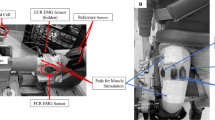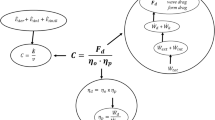Summary
The velocities of motor and sensory nervous conduction and of neuro-muscular transmission were measured in four subjects during a simulated dive at 4.6 MPa (46 bars). The results show an increase in motor distal latency in the ulnar nerve, especially during decompression, with reversibility of the effect on return to ambient conditions. The hypothesis of an interaction of dissolved gases with the membranes of ischaemic cells is proposed.
Similar content being viewed by others
References
Abramson DI, Hlavova A, Rickert B, Talso J, Schwab C, Feldman J, Chu LSW (1970) Effect of ischemia on median and ulnar motor nerve conduction velocities at various temperatures. Arch Physical Med Rehab 51:463–487
Bonnet M, Chouteau J, Hugon M, Imbert G, Roll JP (1973) Activités motrices et spontanées chez le singe sous héliox (99 ATA). Fors Med 9:314–317
Campenot RB (1975) The effects of high hydrostatic pressure on transmission at the crustacean neuro-muscular junction. Comp Biochem Physiol 52B:133–140
Cathala HP (1974) Les effets de l'ischémie sur l'excitabilité et la conduction neuromusculaire chez l'homme normal. Rev EEG Neurophysiol Clin 4:346–354
Chouteau J, Imbert G, Alinat J (1969) Sur une meilleure définition des phénomènes hypoxiques accompagnant la respiration du mélange oxygène-hélium au cours de plongées profondes à saturation. CR Acad Sci (Paris) 268:2918–2921
Fagni L, Weiss M, Pellet J, Hugon M (1982) The possible mechanisms of the high pressure —induced motor disturbance in the cat. Electroenceph Clin Neurophysiol 53:590–601
Geerlings AHC, Mechelse K (1985) Temperature and nerve conduction velocity. Some pratical problems. Electromyogr Clin Neurophysiol 25:253–260
Grapperon J, Trousset A (1986) Modification des vitesses de conduction nerveuse par l'hyperbarie chez l'homme. Rev EEG Neurophysiol Clin 16:165–171
Grundfest H (1936) Effects of hydrostatic pressure upon excitability, the recovery and the potential sequence of frog nerve. Cold Spring Harbour Symp Quantitat Biol 4:179–187
Harris DJ, Bennett PB (1983) Force and duration of muscle twitch contractions in humans at pressures up to 70 bar. J Appl Physiol Environ Exercise Physiol 54:1209–1215
Hugon M, Lemaire C (1975) Cycle d'excitabilité de la fibre nerveuse motrice étudiée chez l'homme normal en hyperbarie à l'hélium. Bull Med Sub Hyp 11:9–13
Hyacinthe R, Broussolle B, Desbruyeres F (1973) Affinité de l'hémoglobine pour l'oxygène chez l'homme en milieu hyperbare (31 ata). Bull Med Sub Hyp 10:44–46
Kendig JJ, Trudell JR, Cohen EN (1975) Effects of pressure and anesthetics on conduction and synaptic transmission. J Pharmacol Exp Therap 195:216–224
Kendig JJ (1984a) Ionic currents in vertebrate myelinated nerve at hyperbaric pressure. Am J Physiol 246:C84-C90
Kendig JJ (1984b) Nitrogen narcosis and pressure reversal of anesthetic effects in node of Ranvier. Am J Physiol 246:C91-C95
Papy JJ, Conte-Devolx J, Pelissier JF, Faugere MC, Corriol J (1977) Etude expérimentale de la conduction nerveuse et neuro-musculaire au cours de la plongée fictive chez le chien et le lapin: corrélations anatomopathologiques. CR Séances Soc Biol (Paris) 171:121–130
Rosner BS, Clark DL, Beck C (1971) Inhalational anesthetics an conduction velocity of human peripheral nerve. Electroenceph Clin Neurophysiol 31:109–114
Rostain JC (1980) Le syndrome nerveux des hautes pressions chez l'homme et le singe Papiopapio. Thèse de Doctorat en Sciences Naturelles, Université d'Aix-Marseille I
Seneviratne KN, Peiris OA, Weerasuriya A (1972) Effects of hyperkalaemia on the excitability of peripheral nerve. J Neurol Neurosurg Psychiat 35:149–155
Spyropoulos C (1957) Response of single nerve fibres at different hydrostatic pressures. J Gen Physiol 40:849–857
Wann KT, McDonald AG (1980) The effects of pressure on excitable cell. Comp Biochem Physiol 66 A: 1–12
Author information
Authors and Affiliations
Additional information
This investigation was supported by the Direction des Recherches, Etudes et Techniques (Grant 86-1024)
Rights and permissions
About this article
Cite this article
Grapperon, J., Trousset, A., Bellard, S. et al. Effects of high pressure on nervous conduction velocity in man. Europ. J. Appl. Physiol. 58, 141–145 (1988). https://doi.org/10.1007/BF00636617
Accepted:
Issue Date:
DOI: https://doi.org/10.1007/BF00636617




